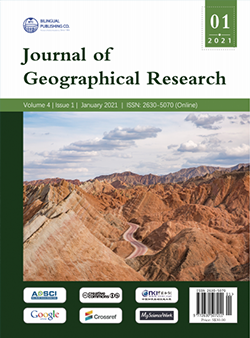-
1344
-
324
-
305
-
257
-
196
Urban Open Space as a Place for Social and Physical Well-being: Narratives from two Different Urban Settings of Kathmandu, Nepal
DOI:
https://doi.org/10.30564/jgr.v4i1.2449Abstract
Increasing population and densification of the cities lead to increasing land value by the high demand of land for housing and other infrastructure developments are the reasons that tend to decreasing open spaces in Kathmandu Valley in general, and Kathmandu Metropolitan City (KMC) in particular. Urban open space has been considered as a place that is accessible to all residents and is important in the urban context as such space provides an opportunity as a place for social interaction, networking, recreation, and various physical health exercises. However, different social and economic contexts of the society reflect different patterns of its uses.Two different urban settings (core urban areas having indigenous dominant population and fringe urban areas having migrants’ dominant population) have been taken as a basis for analysis in this paper to look at how different urban societies use open spaces differently. Open spaces are not only important for maintaining urban greenery and beauty for the city but are valued for accumulating social capital and enhancing physical well-being to urban communities. These issues are analyzed through the interpretative research methodology by collecting the data through in-depth interviews, key informants’ interviews, informal conversational interviews, and nonparticipatory observation from two different urban settings of KMC.
Keywords:
Open Space; Place; Urban Core; Urban Fringe; Well-being; SocietyReferences
[1] Goheen, P.G. Public space and the geography of the modern city. Progress in Human Geography,1998,22 (4):479-496.
[2] Ostrom, E. Governing the commons: The evolution of institutions for collective action. Cambridge: Cambridge University Press, 1990.
[3] Amanda, H. Theorizing the urban commons: New thoughts, tensions and paths forward. Urban Studies,2017, 54(4):1062-1069.
[4] Stanley, B.W., Stark, B.L., et al. Urban open spaces in historical perspective: a transdisciplinary typology and analysis. E-Journal of Research Gate, 2014.Retrieved from https://www.researchgate.net/publication/268208067.
[5] Lofland, L. The public realm: Exploring the city’s quintessential social territory. New York, 1998. NY:Aldine de Gruyter.
[6] Chiesura, A. The role of urban parks for the sustainable city. Landscape and Urban Planning, 2004,68(1):129-138.
[7] Foster, S.R., Iaione, C. The city as a commons.E-Journal of Research Gate, 2016. Retrieved from https://www.researchgate.net/publication/294090007.
[8] Birch L. E. Public and private space in urban areas:house, neighborhood, and city. E-Journal of Research Gate, 2010, 2 (3):118-128.
[9] Borch, C., Kornberger, M. Urban commons: Rethinking the city. London: Rutledge, 2015.
[10] Bruun, M. H. Communities and the commons: Open access and community ownership of the urban commons. In C. Borch & M. Kornberger (eds.), Urban commons: rethinking the city. London: Rutledge,2015.
[11] Garnett, N. S. Managing the urban commons.University of Pennsylvania Law Review, 2012, 160(7):1995-2027.
[12] Soltanian, F., Mohammadi, A. Study of characteristics of urban public open spaces based on social interaction (Case study: Salavatabad’s 3-kilometer route). E-Journal of European Union, 2015.Retrieved from http://www.european-science.com.
[13] Harvey, D. The political economy of public space. In S. M. Low and N. Smith (eds.), The Politics of Public Space. New York, NY: Rutledge, 2006.
[14] Hess, C., Ostrom, E. (eds) Understanding knowledge as a commons: From theory to practice.Cambridge:The MIT Press, 2007.
[15] Bourdieu, P. The forms of capital. In Richardson, J. G.(eds.), Handbook of Theory and Research for the Sociology of Education. New York: Greenwood Press,1986.
[16] Timalsina, K. P. Struggling for livelihood: making a living in the urban informal sector. Germany: VDM Verlag Publisher, 2011.
[17] UN-Habitat. Developing public space and land values in cities and Neighborhoods (discussion paper).Kathmandu: UN-Habitat, 2018.
[18] Low, S., Smith, N. Introduction: The imperative of public space. In Low, S. and Smith, N. (eds.), The politics of public space. London: Rutledge, 2005.
[19] Wooley, H. Urban open space. London and New York: Tailor and Francis, 2003.
[20] Stavrides, S. Commons space: the city as commons.London: ZED Books, 2016.
[21] Pressman, S.D., Kraft, T., Bowlin, S. Well-Being:physical, psychological, social. In Gellman,M.D.,Turner, J.R. (eds). Encyclopedia of Behavioral Medicine. Springer: New York, 2013.
[22] Suwal, B.R. Internal migration in Nepal. In Population Monograph of Nepal, Vol I, 2014:241-276.
[23] CBS. Population statistics of Nepal. Government of Nepal, Central Bureau of Statistics. athmandu:Government of Nepal, 2011.
[24] World Population Data Sheet. World population data.Retrieved from https://www.prb.org/2020-world-population-data-sheet/ acceded on 25 Aug, 2020.
[25] Subedi, B.P. Ethnic/caste diversification in Kathmandu metropolitan: Changing social landscape of a capital city. Journal of Geography and Regional Planning, 2010, 3(8):185-199.
[26] Thapa, R. Spatial process of urbanization in Kathmandu Valley, Nepal, 2009. (Unpublished Ph.D. Thesis). DOI: https://doi.org/10.13140/RG.2.1.2409.3207
[27] Chitrakar, R.M. Transformation of public space in contemporary urban neighborhoods of Kathmandu valley, Nepal: an investigation of changing provision,use and meaning. (Ph.D. Thesis), School of Civil Engineering and Built Environment Faculty of Science and Engineering Queensland University of Technology, 2015.
[28] Hay, I. Qualitative research methods in human geography. New Your; Oxford University Press, 2000.
[29] Patton, M.Q. Qualitative research and evaluation methods (4th ed.). London: Sage Publication, 2015.
[30] Maharjan, S. How open spaces in Kathmandu Valley are shrinking? 2018. CIJ (https://cijnepal.org.np/open-spaces-kathmandu-valley-shrinking/) accessed on 26 Aug, 2020.
[31] KVDA. Atlas of open spaces in Kathmandu Valley.Kathmandu: KVDA, 2015.
[32] DUDBC, National Urban Development Strategy (NUDS). MoUD, DUDBC: Babarmahal, Kathmandu, 2017.
[33] DUDBC. Planning norms and standards. MoUD,DUDBC: Babarmahal, Kathmandu, 2015.
Downloads
How to Cite
Issue
Article Type
License
Copyright © 2021 Krishna Prasad Timalsina

This is an open access article under the Creative Commons Attribution-NonCommercial 4.0 International (CC BY-NC 4.0) License.




 Krishna Prasad Timalsina
Krishna Prasad Timalsina





